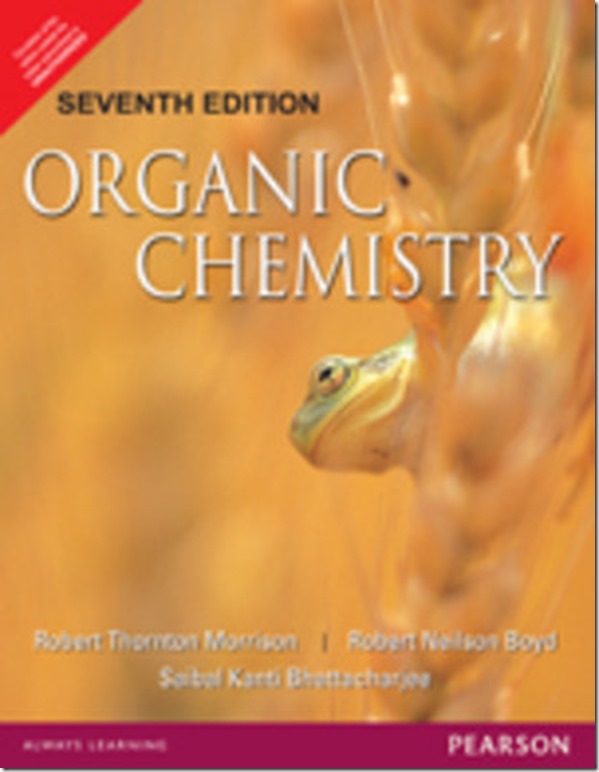Organic Chemistry Pharmacy Textbooks Books:
Latest editions of following books to be adopted for the organic chemistry
1. I. L. Finar: Organic chemistry- Volumes 1 and 2, Pearson Education, Ed:5
2. Morrison and Boyd, Organic chemistry, Prentice Hall.
3. Clayden and Greeves, Organic chemistry, Oxford University Press.
4. S. H. Pine et al, Organic chemistry, McGraw-Hill Science/Engineering/Math.
5. D. Lednicer: Steroid chemistry at a glance, Wiley.
6. Heterocyclic Chemistry, Volume I, Volume II, Volume III by R. R. Gupta, M. Kumar, V. Gupta, Publisher: Springer Nature (SIE)
(2009)
7. Fundamental Principles of Polymeric material, Stephen L. Rosen, Second edition, John Wiley and sons, Inc. (1993)
Pharmaceutics Pharmacy Textbooks Books:
1. Lachman Leon, Liberman Herbert A., Kaing Joseph L., “Theory and practice of Industrial Pharmacy” 3rd edition,1987, Varghese
Publishing house,Mumbai.
2. Liberman Herbert A., rieger, “Pharmaceutical dosage Forms-Disperse Systems”, vol 1/2/3, 2nd edition,2005, Marcel Dekker Inc.,
New York.
3. Allen, Loyd v V.Jr, “Remingtons- the Science and Practice of Pharmacy, Vol 1 / 2, 22nd edition, Pharmaceutical Press
4. Patrik Sinko Ed.”Martin’s Physical Pharmacy and Pharmaceutical Sciences”, 6th edition, 2010,Lippincott Williams and Wilkins.
5. M.E. Aulton Ed.,”Pharmaceutics-The Science of Dosage Form Design”3rd edition,2007,
Churchill livingstone Elsevier Ltd., UK.
6. E.A. Rawlins Ed.,”Bentley’s Textbook of Pharmaceutics”, 2010, Elsevier Publications.
7. S.J.Carter Ed.,”Tutorial Pharmacy-Cooper & Gunn”, 6th edition,1986, CBS Publishers & distributors, India.
8. Pharmacopeias-IP, BP, USP-latest editions
9. Harry’s Cosmeticology Edited by J. B. Wilkinson and R. J. Moore, Longman Scientific & Technical Publishers
10. Cosmetics Science and Technology, Edited by M. S. Balsam, E. Sagarin, S. D. Gerhon, S. J. Strianse and M. M. Rieger, Volumes
1,2 and 3.Wiley-Interscience, Wiley India Pvt. Ltd.
11. Poucher’s Perfumes, cosmetics & Soaps, Editor- Hilda Butler, Klewer Academic Publishers,Netherlands
12. Cosmetic Technology, Ed. By S. Nanda, A. Nanda and R. Khar, Birla Publications Pvt. Ltd., New Delhi
13. Encyclopedia of Pharmaceutical Technology, Vol. 6, Eds. James Swarbrick, James C. Boylan, Marcel Dekker Inc.
14. BIS Guidelines for different cosmetic products.
15. Formulation and function of cosmetics by Jellinek Stephan, Wiley Interscience.
16. Remington: The Science and Practice of Pharmacy, Lippincott Williams & Wilkins, 2006.
Pharmaceutical Biotechnology Pharmacy Textbooks Books:
1. R. C. Dubey, A textbook of biotechnology
2. B. D. Singh, Biotechnology.
3. S. P. Vyas and Dixit, Pharmaceutical Biotechnology, CBS publisher & distributers.
4. S. S. Kori, Pharmaceutical Biotechnology.
5. H. D. Kumar, Biotechnology, Affiliate East-West press Pvt. Ltd New Delhi.
6. Ananthnarayan, A textbook of microbiology, Orient Longman Pvt. Ltd.
7. W. B. Hugo and A. D. Russell, Pharmaceutical Microbiology, Blackwell Science.
8. David, Nelson, Lehninger – Principle of Biochemistry, W. H. Freeman & Co.
9. Pelezar, Chan & Krieg, Microbiology-Concepts and Applications, International Edn., McGraw Hill, Inc.,
10. Weir Stewart: Immunology, Churchill Livingstone.
11. Chandrakant Kakote, Pharmaceutical Biotechnology.
12.Desmond S.T. Nicholl, An introduction to genetic engineering, Panima Publishing Corporation, New Delhi.
13. Stanbury F. P., Whitakar A., and Hall J.S. Principles of fermentation technology,2nd edition. Aditya books LTD., New Delhi.
Pharmacology Pharmacy Textbooks Books:
1. Goodman & Gilman’s Pharmacological Basis of Therapeutics, McGraw Hill Companies Inc.
2. Satoskar R.S. Bhandarkar S.D. & Rege N. N. Pharmacology & Therapeutics, Popular Prakashan.
3. Rang & Dale Pharmacology, Churchill Livingstone.
4. Lippincott’s Illustrated Reviews: Pharmacology- Lippincott-Raven Howland & Nyeets Publishers NY.
5. Laurence D. R. & Bennett Clinical Pharmacology, Elsevier NY.
6. Kulkarni S. K. Handbook of Experimental Pharmacology, Vallabh Prakashan, New Delhi.
7. Katzung B. G. -Basic and Clinical Pharmacology, Appleton and Lange publications.
8. Ghosh M. N. Fundamentals of Experimental Pharmacology Hilton & Company, Kolkata.
Biochemistry Text books
Books:
1. Meyers, R. A., Molecular Biology and Biotechnology, Wiley-VCH, 2000.
2. Lodish, H. Molecular Cell Biology, 6th Edition, W. H. Freeman and Co., NY, USA.
3. Rose, P. Molecular Biotechnology, Panima, 2000.
4. Brown, T. A., Molecular Biology, Vol. I and II, Academic Press, 2000.
5. B. Lewin, Genes IX, 9th Edition, Jones and Barlett Pub., USA, 2007.
6. Watson J. D. Molecular Biology of the Gene, Benjamin Cummings; 6th Edition, 2007.
7. D,.Nelson and M.Cox, (2005), “Lehninger’s Principles of biochemistry”, 4th ed., Macmillan worth Publishers.
Nutraceuticals and Dietary Supplements -(2 Hr/Wk)
1. Handbook of Nutraceuticals and Functional Foods, Second Edition, Eds Robert E.C. Wildman, CRC Press, Taylor and Francis
2. Nutraceuticals: A Guide for Healthcare Professionals, Brian Lockwood
3. Nutraceuticals in Health and Disease Prevention edited by Klaus Kramer, Peter-Paul Hoppe, Lester Packer, Marcel Decker New
York
4. Nutraceuticals: Efficacy, Safety and Toxicity edited by Ramesh C. Gupta Academic Press, Elsevier Publication
5. Handbook of Nutraceuticals Volume I: Ingredients, Formulations, and Applications edited by Yashwant Vishnupant Pathak, CRC
Press, Taylor and Francis
6. Nutraceuticals edited by Alexandru Grumezescu, Academic Press Elsevier
7. Nutraceuticals, Glycemic Health and Type 2 Diabetes, Eds Vijai K. Pasupuleti, James W. Anderson, Wiley Blackwell Publications
8. Regulation of Functional Foods and Nutraceuticals: A Global Perspective, Ed Clare M. Hasler, Blackwell Publishing
9. Developing New Functional Food and Nutraceutical Products edited by Debasis Bagchi, Sreejayan Nair, Academic Press, Elsevier
Publishing
10. Phytosterols as Functional Food Components and Nutraceuticals, Ed Paresh C. Dutta, Marcel Decker Publishing
11. Phenolics in Food and Nutraceuticals, Fereidoon Shahidi, Marian Naczk, CRC press
12. Bioactive Proteins and Peptides as Functional Foods and Nutraceuticals, Eds Yoshinori Mine, Eunice Li-Chan, Bo Jiang, Wiley
Blackwell
13. Marine Nutraceuticals and Functional Foods, Ed Colin Barrow, Fereidoon Shahidi, CRC press
14. Role of dietary fibres and nutraceuticals in preventing diseases, K. T Agusti and P.Faizal, B S Publication
15. Goldberg, I. Functional Foods. Chapman and Hall, New York.
16. Labuza, T.P. Functional Foods and Dietary Supplements: Safety, Good Manufacturing Practice (GMPs) and Shelf Life Testing in
Essentials of Functional Foods, Eds M.K. Sachmidl and T.P. Labuza, Aspen Press.
Microbial Genetics Text Books
. Peter J. Russell (2006), “Genetics-A molecular approach”, 2nd ed.
2. Benjamin A. Pierce (2008), “Genetics a conceptual approach”, 3rd ed., W. H. Freeman and company.
3. R. H. Tamarin, (2004), “Principles of genetics”, Tata McGraw Hill.
4. D. Nelson and M. Cox, (2005), “Lehninger’s Principles of biochemistry”, 4th ed., Macmillan worth Publishers.
5. M. Madigan, J. Martinko, J. Parkar, (2009), “Brock Biology of microorganisms”, 12th ed., Pearson Education International.
6. Fairbanks and Anderson, (1999), “Genetics”, Wadsworth Publishing Company.
7. Prescott, Harley and Klein, “Microbiology”,. 7th edition Mc Graw Hill international edition.
8. Robert Weaver, “Molecular biology”, , 3rd edn. Mc Graw Hill international edition.
9. Nancy Trun and Janine Trempy, (2004), “Fundamental bacterial genetics”, Blackwell Publishing
10. Snustad, Simmons, “Principles of Genetics”, 3rd edn. John Wiley & sons, Inc.
Packaging of Pharmaceuticals – (2 Hr/Wk)
‘
1. D. A. Dean, Roy Evans, Ian Hall. Pharmaceutical packaging technology. Tylor and Francis, London.
2. Edward J. Bauer, Pharmaceutical Packaging Handbook. Bausch and Lomb, Rochester, New York, USA.
3. Wilmer A. Jenkins, Kenton R. Osborn. Packaging drugs and pharmaceuticals.
4. Salvatore J. Turco, Sterile dosage forms: their preparation and clinical applications
5. Remington: The Science and Practice of Pharmacy, Lippincott Williams & Wilkins, 2006.
6. Michael E. Aulton, Kevin Tylor (Ed.). Aulton’s Pharmaceutics: The design and Manufacture of Medicine.
7. Gilbert Banker and Christopher Rhodes. Modern Pharmaceutics.
8. Leon Lachman; Lieberman Herbert A.; Kanig, Joseph L. The theory and Practice of Industrial Pharmacy.
9. Hanlon J., Robert J. Kelsey, “Handbook of Package Engineering” 2nd Edition, McGraw-Hill, New. York. 1984
10. Paine A., “Packaging User’s Handbook”, Springer, 1990
11. K. Avis, Liberman and Lachman, Pharmaceutical Dosage Forms: Parenterals, Vol. I, Marcel Dekker, Expanded ad revised edition,
2008.





